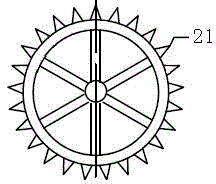Sealing material for preventing rodents and pests from passing through and manufacturing process thereof
A sealing material and manufacturing process technology, applied in animal repellents, textiles and papermaking, non-woven fabrics, etc., can solve the problems of metal fiber pilling, environmental pollution, insufficient strength, etc., to enhance tensile strength, process flow Simple, even thickness effect
- Summary
- Abstract
- Description
- Claims
- Application Information
AI Technical Summary
Benefits of technology
Problems solved by technology
Method used
Image
Examples
Embodiment 1
[0041] Step 1: Cut the loose No. 3 434 stainless steel velvet cotton into 18cm long pieces;
[0042] Step 2: Select a flat tendon belt with a thickness of 3mm and a width of 60mm to be placed on the conveyor 1. The ratio of stainless steel velvet cotton to flame-retardant chemical fiber is 6:2.5, and the conveyor belt 11 is driven by the conveyor 1 to cut into small pieces. No. 3 434 stainless steel velvet cotton and flame-retardant chemical fiber are sent into the opener 2 and opened for 5 minutes to obtain a mixed fabric 20 of metal and chemical fiber, such as figure 1 As shown, the tooth profile of the hob 21 on the opener 2 is adjusted to be conical, as figure 2 shown;
[0043] Step 3: Send the mixed fabric 20 of metal and chemical fiber after opening and mixing into the cotton box 4 through the suction machine 3. The suction diameter of the suction machine 3 is 1.5 inches, and the suction speed is 300kg / h;
[0044] Step 4: The metal and chemical fiber mixed fabric 20 o
Embodiment 2
[0050] Step 1: Cut the loose No. 3 434 stainless steel velvet cotton into 19cm long pieces;
[0051] Step 2: Select a flat tendon belt with a thickness of 3mm and a width of 60mm to be placed on the conveyor 1. The ratio of stainless steel velvet cotton to flame-retardant chemical fiber is 6.5:2.8, and the conveyor belt 11 is driven by the conveyor 1 to cut into small pieces. No. 3 434 stainless steel velvet cotton and flame-retardant chemical fiber are sent into the opener 2 and opened for 8 minutes to obtain a mixed fabric 20 of metal and chemical fiber, such as figure 1 As shown, the tooth profile of the hob 21 on the opener 2 is adjusted to be conical, as figure 2 shown;
[0052] Step 3: Send the mixed fabric 20 of metal and chemical fiber after opening and mixing into the cotton box 4 through the suction machine 3. The suction diameter of the suction machine 3 is 2 inches, and the suction speed is 350kg / h;
[0053] Step 4: The metal and chemical fiber mixed fabric 20 o
Embodiment 3
[0059] Step 1: Cut the loose No. 3 434 stainless steel velvet cotton into 20cm long pieces;
[0060] Step 2: Select a flat tendon belt with a thickness of 3mm and a width of 60mm to be placed on the conveyor 1. The ratio of stainless steel velvet cotton to flame-retardant chemical fiber is 7:3, and the conveyor belt 11 is driven by the conveyor 1 to cut into small pieces. No. 3 434 stainless steel velvet cotton and flame-retardant chemical fiber are sent into the opener 2 and opened for 10 minutes to obtain a mixed fabric 20 of metal and chemical fiber, such as figure 1 As shown, the tooth profile of the hob 21 on the opener 2 is adjusted to be conical, as figure 2 shown;
[0061] Step 3: Send the mixed fabric 20 of metal and chemical fiber after opening and mixing into the cotton box 4 through the suction machine 3. The suction diameter of the suction machine 3 is 2.5 inches, and the suction speed is 400kg / h;
[0062] Step 4: The metal and chemical fiber mixed fabric 20 ou
PUM
| Property | Measurement | Unit |
|---|---|---|
| Thickness | aaaaa | aaaaa |
Abstract
Description
Claims
Application Information
 Login to view more
Login to view more - R&D Engineer
- R&D Manager
- IP Professional
- Industry Leading Data Capabilities
- Powerful AI technology
- Patent DNA Extraction
Browse by: Latest US Patents, China's latest patents, Technical Efficacy Thesaurus, Application Domain, Technology Topic.
© 2024 PatSnap. All rights reserved.Legal|Privacy policy|Modern Slavery Act Transparency Statement|Sitemap



